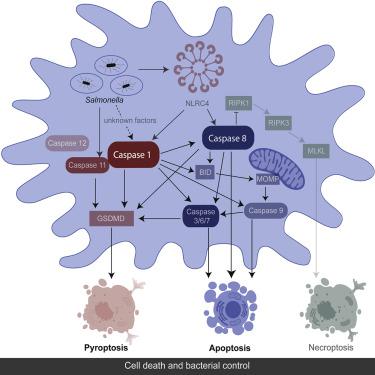Immunity ( IF 32.4 ) Pub Date : 2020-07-30 , DOI: 10.1016/j.immuni.2020.07.004 Marcel Doerflinger 1 , Yexuan Deng 2 , Paul Whitney 3 , Ranja Salvamoser 1 , Sven Engel 3 , Andrew J Kueh 1 , Lin Tai 4 , Annabell Bachem 3 , Elise Gressier 3 , Niall D Geoghegan 1 , Stephen Wilcox 1 , Kelly L Rogers 1 , Alexandra L Garnham 1 , Michael A Dengler 1 , Stefanie M Bader 4 , Gregor Ebert 1 , Jaclyn S Pearson 5 , Dominic De Nardo 6 , Nancy Wang 3 , Chenying Yang 3 , Milton Pereira 7 , Clare E Bryant 8 , Richard A Strugnell 3 , James E Vince 1 , Marc Pellegrini 1 , Andreas Strasser 1 , Sammy Bedoui 3 , Marco J Herold 1

|
Programmed cell death contributes to host defense against pathogens. To investigate the relative importance of pyroptosis, necroptosis, and apoptosis during Salmonella infection, we infected mice and macrophages deficient for diverse combinations of caspases-1, -11, -12, and -8 and receptor interacting serine/threonine kinase 3 (RIPK3). Loss of pyroptosis, caspase-8-driven apoptosis, or necroptosis had minor impact on Salmonella control. However, combined deficiency of these cell death pathways caused loss of bacterial control in mice and their macrophages, demonstrating that host defense can employ varying components of several cell death pathways to limit intracellular infections. This flexible use of distinct cell death pathways involved extensive cross-talk between initiators and effectors of pyroptosis and apoptosis, where initiator caspases-1 and -8 also functioned as executioners when all known effectors of cell death were absent. These findings uncover a highly coordinated and flexible cell death system with in-built fail-safe processes that protect the host from intracellular infections.
中文翻译:

多样的细胞死亡途径的灵活用法和互连性可防止细胞内感染。
程序性细胞死亡有助于宿主防御病原体。为了调查沙门氏菌感染过程中发烧,坏死和凋亡的相对重要性,我们感染了缺乏caspases-1,-11,-12和-8和受体相互作用的丝氨酸/苏氨酸激酶3(RIPK3)多种组合的小鼠和巨噬细胞。发烧,半胱天冬酶8驱动的凋亡或坏死性坏死对沙门氏菌的影响较小控制。但是,这些细胞死亡途径的综合缺乏导致小鼠及其巨噬细胞失去细菌控制,表明宿主防御可以利用几种细胞死亡途径的不同组成部分来限制细胞内感染。灵活使用不同的细胞死亡途径涉及引发细胞凋亡和凋亡的效应子之间的广泛串扰,其中当缺少所有已知的细胞死亡效应子时,引发剂caspases-1和-8也充当执行者。这些发现揭示了具有高度协调性和灵活性的细胞死亡系统,该系统具有内置的故障保护过程,可以保护宿主免受细胞内感染。

























 京公网安备 11010802027423号
京公网安备 11010802027423号